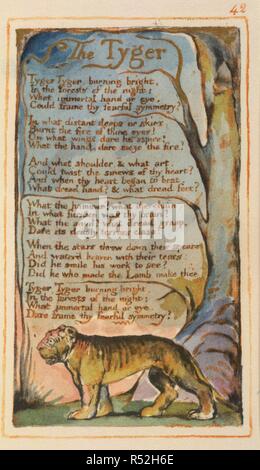
This is because the Creator who made the tiger is not meant to be understood by us: he works in mysterious ways.īut is the Christian belief-system the only way of approaching Blake’s Tyger? Returning to the significance of fire in the poem, it’s worth noting that this fiery imagery also summons the idea of Greek myth – specifically, the myth of Prometheus, the deity who stole fire from the gods and gave it to mankind.įrom that daring act of transgression, man’s development followed. Question after question comes at us, and an answer to any of them seems impossible: ‘the speaker can do no more than wonder’, as Gillham notes. Gillham observes that whereas the child-speaker of ‘The Lamb’ is confident in, and proud of, his knowledge of the lamb (‘Little Lamb, I’ll tell thee …’), the speaker of ‘The Tyger’ is marked by uncertainty. Gillham, in his informative and fascinating study of Blake’s poetry, Blake’s Contrary States: The ‘Songs of Innocence and Experience’ as Dramatic Poems, puts it: ‘A universe that contains beasts of prey must be a ruthless one, and his questions are so framed that any possible answer must first explain that.’Ĭertainly, when we contrast ‘The Lamb’ with ‘The Tyger’, we realise that although the speakers of both poems ask questions, the crucial difference is that the questions are left unanswered in the latter poem.


The tiger, whilst not a biblical animal, embodies the violent retribution and awesome might of Yahweh in the Old Testament. What bolsters such an interpretation is the long-established associations between the lamb and Jesus Christ. Indeed, we might take such an analysis further and see the duality between the lamb and the tiger as being specifically about the two versions of God in Christianity: the vengeful and punitive Old Testament God, Yahweh, and the meek and forgiving God presented in the New Testament. (‘Fearful’ means ‘fearsome’ here, confusingly.) (This might help to explain Blake’s reference to ‘fearful symmetry’: he is describing not only the remarkable patterns on the tiger’s skin and fur which humans have learned to go in fear of, but the ‘symmetry’ between the innocent lamb on the one hand and the fearsome tiger on the other. Presumably the question is rhetorical the real question-behind-the-question is why.


How might we analyse ‘The Tyger’? What does it mean? The broader point is one that many Christian believers have had to grapple with: if God is all-loving, why did he make such a fearsome and dangerous animal? We can’t easily fit the tiger into the ‘All Things Bright and Beautiful’ view of Christian creation.Īs Blake himself asks, ‘Did he who made the Lamb make thee?’ In other words, did God make the gentle and meek animals, but also the destructive and ferocious ones?


 0 kommentar(er)
0 kommentar(er)
